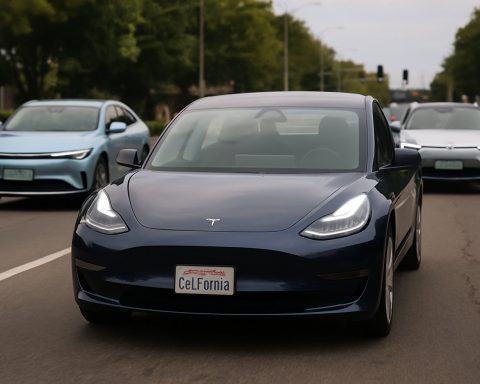From Battlefield Signals to Next-Gen Networks: Unveiling the Evolution of Military Radio and Telecommunications
- Market Overview: Shifting Paradigms in Military Communications
- Technology Trends: Innovations Shaping Defense Connectivity
- Competitive Landscape: Key Players and Strategic Moves
- Growth Forecasts: Projected Expansion and Investment Hotspots
- Regional Analysis: Comparing Global Defense Communication Markets
- Future Outlook: Anticipating the Next Wave of Military Telecom
- Challenges & Opportunities: Navigating Barriers and Unlocking Potential
- Sources & References
“Modern militaries rely on robust communication networks to coordinate operations, from secure battlefield radios to satellites and smartphone-based systems.” (source)
Market Overview: Shifting Paradigms in Military Communications
The evolution of military radio and telecommunications has been marked by rapid technological advancements, fundamentally transforming how armed forces communicate and coordinate operations. From the rudimentary field phones of the early 20th century to the integration of 5G networks, each leap in technology has brought increased speed, security, and operational flexibility.
During World War I and II, field telephones and basic radio sets were the backbone of military communications, enabling real-time coordination over limited distances. The Cold War era saw the introduction of more sophisticated radio systems, including frequency-hopping and encrypted communications, to counteract interception and jamming threats (Army Technology).
The late 20th and early 21st centuries ushered in the digital age, with militaries adopting satellite communications (SATCOM), secure mobile networks, and software-defined radios (SDRs). These technologies allowed for global reach, interoperability among allied forces, and enhanced data transmission capabilities. For instance, the U.S. Department of Defense’s Joint Tactical Radio System (JTRS) program exemplified the shift towards network-centric warfare, enabling seamless voice, data, and video communications across platforms (U.S. Government Accountability Office).
Today, the integration of 5G technology is poised to revolutionize military communications further. 5G offers ultra-low latency, high bandwidth, and the ability to connect massive numbers of devices, supporting real-time situational awareness, autonomous systems, and advanced command and control applications. According to a 2023 report by MarketsandMarkets, the global military communications market is projected to grow from $24.2 billion in 2023 to $35.4 billion by 2028, driven largely by investments in next-generation networks and cybersecurity (MarketsandMarkets).
- Key Trends: Adoption of 5G and edge computing, increased focus on cybersecurity, and the use of artificial intelligence for network management.
- Challenges: Securing communications against cyber threats, ensuring interoperability among legacy and new systems, and managing spectrum allocation.
- Opportunities: Enhanced situational awareness, improved command and control, and support for unmanned and autonomous platforms.
In summary, the shift from field phones to 5G reflects a broader transformation in military communications, emphasizing speed, security, and adaptability to meet the demands of modern warfare.
Technology Trends: Innovations Shaping Defense Connectivity
The evolution of military radio and telecommunications has been marked by rapid technological advancements, fundamentally transforming defense connectivity. From the rudimentary field phones of World War I to the integration of 5G networks, each innovation has enhanced the speed, security, and reliability of military communications.
Early Innovations: Field Phones and Analog Radios
- During World War I and II, field telephones and analog radios enabled real-time communication between command posts and front-line units. These systems, while revolutionary for their time, were limited by range, vulnerability to interception, and susceptibility to environmental factors (U.S. Army).
Cold War Era: Secure and Mobile Communications
- The Cold War period saw the introduction of frequency-hopping radios and encrypted communication systems, such as the SINCGARS (Single Channel Ground and Airborne Radio System), which improved resistance to jamming and interception (U.S. Army).
- Satellite communications (SATCOM) emerged, enabling global reach and supporting operations in remote or hostile environments (NASA).
Digital Transformation: Network-Centric Warfare
- The 21st century ushered in digital radios, software-defined radios (SDRs), and IP-based networks, allowing seamless integration of voice, data, and video across platforms (NATO).
- Network-centric warfare concepts rely on robust, secure, and interoperable communications to provide real-time situational awareness and decision-making capabilities.
5G and Beyond: The Future of Military Connectivity
- 5G technology promises ultra-low latency, high bandwidth, and massive device connectivity, supporting applications such as autonomous vehicles, augmented reality, and Internet of Battlefield Things (IoBT) (U.S. Department of Defense).
- The U.S. Department of Defense has invested over $600 million in 5G testbeds at military bases, aiming to enhance command and control, logistics, and training (DoD Press Release).
As military operations become increasingly data-driven, the evolution from field phones to 5G underscores the critical role of advanced telecommunications in ensuring mission success and operational superiority.
Competitive Landscape: Key Players and Strategic Moves
The competitive landscape of military radio and telecommunications has evolved dramatically, shaped by technological innovation, shifting defense priorities, and the entrance of new players. Historically, the market was dominated by a handful of Western defense contractors, but the transition from analog field phones to advanced 5G-enabled systems has broadened the field and intensified competition.
- L3Harris Technologies: A global leader, L3Harris has consistently invested in secure, software-defined radios (SDRs) and networking solutions. Their Falcon IV® family, adopted by the U.S. Army, exemplifies the shift toward multi-band, multi-mission platforms supporting voice, data, and video over secure networks.
- Thales Group: Thales remains a key player in Europe and beyond, with its SYNAPS radio family offering scalable, interoperable solutions. The company is investing in 5G integration and AI-driven spectrum management to enhance battlefield connectivity.
- BAE Systems: BAE has focused on resilient communications, recently unveiling next-generation tactical radios with anti-jamming and low-probability-of-intercept features, addressing the growing threat of electronic warfare.
- Rohde & Schwarz: This German firm is a leader in secure communications for NATO and allied forces, with its SDR-based SOVERON® platform supporting seamless integration with legacy and next-gen systems.
- Huawei and ZTE: Chinese firms are rapidly advancing in military 5G, with Huawei reportedly supplying secure 5G solutions for the People’s Liberation Army, raising concerns about global supply chain security and technological sovereignty.
Strategic moves include aggressive R&D investment, cross-border partnerships, and acquisitions. The U.S. Department of Defense’s 5G-to-Next G Initiative is accelerating adoption of commercial 5G technologies for military use, while NATO’s Defence Innovation Accelerator is fostering collaboration among allies. As the market shifts from legacy systems to 5G and beyond, the competitive landscape will continue to be defined by innovation, interoperability, and the race for secure, resilient communications.
Growth Forecasts: Projected Expansion and Investment Hotspots
The evolution of military radio and telecommunications has been marked by rapid technological advancements, shifting from rudimentary field phones to sophisticated 5G-enabled systems. This transformation is not only enhancing battlefield communication but also driving significant market growth and attracting robust investment across key regions.
Market Growth and Projections
The global military communications market was valued at approximately USD 37.7 billion in 2023 and is projected to reach USD 47.6 billion by 2028, growing at a CAGR of 4.8%. This expansion is fueled by the increasing demand for secure, real-time data transmission, the integration of advanced technologies such as artificial intelligence (AI) and the Internet of Things (IoT), and the modernization of defense infrastructure worldwide.
Technological Evolution: From Field Phones to 5G
- Field Phones and Analog Radios: Early military communications relied on wired field telephones and analog radios, which, while reliable, were limited in range and susceptible to interception.
- Digital and Encrypted Systems: The shift to digital radios in the late 20th century improved clarity, range, and security, with encryption becoming standard to protect sensitive information.
- Software-Defined Radios (SDR): SDRs have enabled greater flexibility, allowing forces to switch frequencies and protocols dynamically, enhancing interoperability among allied forces.
- 5G and Beyond: The adoption of 5G is set to revolutionize military communications, offering ultra-low latency, high bandwidth, and the ability to connect a vast array of devices on the battlefield. According to Fortune Business Insights, 5G integration is a key driver for future market growth, enabling real-time situational awareness and autonomous systems.
Investment Hotspots
- North America: The U.S. Department of Defense continues to lead in R&D and procurement, with major investments in next-generation tactical radios and secure 5G networks (U.S. DoD).
- Europe: NATO modernization programs and increased defense spending in response to geopolitical tensions are driving demand for advanced communication systems.
- Asia-Pacific: Rapid military modernization in China, India, and South Korea is creating lucrative opportunities for technology providers and investors.
As military operations become increasingly network-centric, the evolution from field phones to 5G is not only transforming defense communications but also shaping the global investment landscape in this sector.
Regional Analysis: Comparing Global Defense Communication Markets
The evolution of military radio and telecommunications has been pivotal in shaping modern defense strategies across the globe. From the rudimentary field phones of the early 20th century to the integration of 5G networks, the technological landscape has transformed the way armed forces communicate, coordinate, and execute operations.
Historically, field telephones and analog radios were the backbone of military communications, providing basic voice connectivity on the battlefield. However, these systems were often limited by range, susceptibility to interception, and lack of data capabilities. The Cold War era saw the introduction of more secure and robust radio systems, such as frequency-hopping spread spectrum (FHSS) radios, which improved resistance to jamming and eavesdropping (Army Technology).
In recent decades, digitalization has revolutionized military communications. The adoption of software-defined radios (SDRs) has enabled interoperability between different branches and allied forces, allowing for real-time data, voice, and video transmission. For example, the U.S. Joint Tactical Radio System (JTRS) program exemplifies this shift, aiming to unify communications across platforms (U.S. Government Accountability Office).
Globally, the defense communication market is experiencing rapid growth, driven by the need for secure, high-speed, and resilient networks. According to a 2023 report, the global military communications market is projected to reach $40.6 billion by 2028, growing at a CAGR of 4.2% (MarketsandMarkets).
- North America: The U.S. leads in adopting advanced technologies, including 5G and satellite-based systems, to support network-centric warfare and autonomous platforms.
- Europe: NATO members are investing in secure, interoperable communication networks, with a focus on cyber resilience and integration of legacy systems.
- Asia-Pacific: China and India are rapidly modernizing their military communications, emphasizing indigenous development and 5G integration for enhanced situational awareness.
The transition to 5G is particularly significant, promising ultra-low latency, massive device connectivity, and enhanced bandwidth. This enables new capabilities such as real-time drone swarms, augmented reality for soldiers, and seamless command-and-control across dispersed units (Defense News). As nations race to modernize, the evolution from field phones to 5G underscores the strategic importance of robust, secure, and adaptive military telecommunications.
Future Outlook: Anticipating the Next Wave of Military Telecom
The evolution of military radio and telecommunications has been marked by rapid technological advancements, transforming the way armed forces communicate and coordinate operations. From the rudimentary field phones of the early 20th century to the integration of 5G networks, each leap in technology has enhanced the speed, security, and reliability of military communications.
Historically, field telephones and analog radios provided the backbone for tactical communications, but these systems were limited by range, susceptibility to interception, and bandwidth constraints. The Cold War era saw the introduction of frequency-hopping radios and encrypted communication systems, significantly improving operational security (U.S. Army).
In recent decades, digitalization has revolutionized military telecom. The adoption of software-defined radios (SDRs) has enabled interoperability across different platforms and nations, while satellite communications (SATCOM) have extended connectivity to even the most remote theaters of operation. According to the MarketsandMarkets report, the global military communications market is projected to grow from $24.2 billion in 2023 to $29.9 billion by 2028, driven by modernization initiatives and the need for secure, high-speed data transmission.
The next wave is being shaped by the integration of 5G technology. 5G promises ultra-low latency, high bandwidth, and the ability to connect a vast array of devices, supporting real-time data sharing, autonomous systems, and enhanced situational awareness. The U.S. Department of Defense has already launched several pilot projects to test 5G applications in logistics, augmented reality training, and smart bases (U.S. Department of Defense).
- Enhanced Security: Advanced encryption and network slicing in 5G networks will bolster protection against cyber threats.
- Network Resilience: Mesh networking and edge computing will ensure robust communications even in contested environments.
- Interoperability: Open standards and modular systems will facilitate seamless coalition operations.
As military operations become increasingly data-driven, the evolution from field phones to 5G-enabled networks will be pivotal in maintaining information superiority and operational effectiveness in future conflicts.
Challenges & Opportunities: Navigating Barriers and Unlocking Potential
The evolution of military radio and telecommunications from rudimentary field phones to advanced 5G-enabled systems has been marked by both significant challenges and transformative opportunities. As armed forces worldwide strive to maintain secure, reliable, and rapid communications, the sector faces a complex landscape shaped by technological innovation, cybersecurity threats, and the need for interoperability.
-
Challenges:
- Legacy Systems Integration: Many militaries still rely on older analog and early digital systems, creating compatibility issues with modern, software-defined radios and 5G networks. Upgrading or replacing these systems is costly and logistically complex (NATO).
- Cybersecurity Risks: As communications move to IP-based and wireless platforms, the risk of cyberattacks, jamming, and interception increases. In 2023, the U.S. Department of Defense reported a 30% rise in attempted cyber intrusions targeting military communications (U.S. Department of Defense).
- Spectrum Management: The proliferation of commercial 5G networks has intensified competition for radio frequency spectrum, complicating military access and requiring advanced spectrum-sharing solutions (CNAS).
- Interoperability: Multinational operations demand seamless communication between allied forces, but differing standards and encryption protocols often hinder effective collaboration (NATO).
-
Opportunities:
- 5G and Beyond: The adoption of 5G technology promises ultra-low latency, high bandwidth, and network slicing, enabling real-time data sharing, autonomous systems, and enhanced situational awareness (Army Technology).
- Software-Defined Radios (SDR): SDRs offer flexibility, allowing forces to update waveforms and encryption remotely, improving adaptability and future-proofing investments (Army Technology).
- Artificial Intelligence (AI): AI-driven network management and threat detection can automate responses to jamming and cyber threats, increasing resilience and operational efficiency (NATO Review).
- Global Collaboration: Initiatives like NATO’s Federated Mission Networking are fostering interoperability and shared standards, unlocking new levels of coalition effectiveness (NATO).
In summary, while the transition from field phones to 5G presents formidable barriers, it also unlocks unprecedented potential for secure, agile, and integrated military communications.
Sources & References
- From Field Phones to 5G: The Evolution of Military Radio and Telecommunications
- Army Technology
- U.S. Government Accountability Office
- MarketsandMarkets
- U.S. Army
- NASA
- Falcon IV®
- SYNAPS radio family
- SDR-based SOVERON®
- Defense News
- Fortune Business Insights
- CNAS












